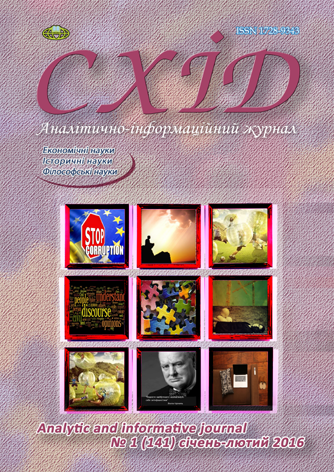Role of financial architectonic in support of development of economic systems
DOI:
https://doi.org/10.21847/1728-9343.2016.1(141).173144Keywords:
financial architectonic, national wealth, labor productivity, development of economic systemAbstract
Article studies level of influence of financial architectonic to the economic systems development. The essence of economic category "financial architectonic" is revealed, its characteristics are determined, namely: represents set of elements of financial system; is an integral system of the financial space; distribution and redistribution of financial resources and capital; has ability of renovation and qualitative changes according to challenges of globalization processes. Scientific heritage of such scholars as T. Beck, M. Miller, R. Levin, R. Lucas, J. Robinson, J. Schumpeter, were considered for determination of influence degree of financial mechanisms to economic growth. Conducted research allowed to obtain following results: banks, non-banking financial institutions and equity markets are more developed in rich countries with strong economies; effectiveness and depth of the national financial architectonic directly affects labor productivity and national wealth accumulation, representing key factor in the development of economic systems.
Downloads
References
The World Bank, (2013). “Global financial development report: rethinking the role of the state in finance”. The World Bank, Washington.
Bodie, Z. and Merton, R.C. (2005). “Design of financial systems: towards a synthesis of function and structure”, Journal of investment management, vol. 3, p. 17.
Gricenko, A.A. (2008). Institucional'naja arhitektonika i dinamika jekonomicheskih preobrazovanij, Fort, Har'kov (ukr).
Vozhzhov, A.P. and Hryn'ko, O.L. (2012). “Teoretychni aspekty formuvannia arkhitektury finansovoho stymuliuvannia ekonomichnoho zrostannia”, Finansy Ukrainy, no 10, pp. 20 - 33 (ukr).
Hluschenko, O. V. (2013). “Finansova arkhitektonika: teoretyko-metodolohichnyj aspect”, Nauka j ekonomika: naukovo-teoretychnyj zhurnal Khmel'nyts'koho ekonomichnoho universytetu, vol. 4 (32), pp. 43-52 (ukr).
Stetsiuk, P. (2014). “Arkhetypni osnovy finansovoi arkhitektoniky rehional'nykh sotsial'no-ekonomichnykh system”, Publichne upravlinnia: teoriia ta praktyka, vol. 2, pp. 195-199 (ukr).
Kolosova, V.P. (2012). “Finansova hlobalizatsiia ta riven' intehratsii krainy u svitovyj finansovyj prostir, Stratehiia rozvytku Ukrainy. Ekonomika, sotsiolohiia, parvo, no 1, pp. 121 - 126 (ukr).
Medvedkina, Ye.O. (2015). “Suchasna paradyhma reformuvannia svitovoi finansovoi systemy”, Visnyk Donets'koho natsional'noho universytetu, Ser. V: Ekonomika i parvo, vol. 1, pp. 476 - 480 (ukr).
Bodie, Z., Merton, R.C., Cleeton, D.L. (2009). “Financial Economics”. 2nd ed. Pearson Prentice Hall, New Jersey
Gambacorta, L., Yang, J., Tsatsaronis, K. (2014). “Financial Structure and Growth”, BIS Quarterly Review.
Robinson, J. (1952). “The Generalization of the General Theory”, The Rate of Interest and Other Essays, MacMillan, London.
Schumpeter, J. A. (1934). “The Theory of Economic Development”, Harvard University Press, Cambridge.
Levine, R., Loayza, N., Beck, T. (2000). “Financial Intermediation and Growth: Causality and Causes”, Journal of Monetary Economics, vol. 46, pp. 31-77.
Peter, L. (2003). “Rousseau Historical Perspectives on Financial Development and Economic Growth”, Federal reserve bank of st. Louis, pp. 81 - 103.
Rajan, R. G. and Zingales, L. (1998). “Financial Dependence and Growth”, American Economic Review, vol.88, pp. 559-586.
Levine, R. and Zervos, S. (1998). “Stock Markets, Banks, and Economic Growth”, The American Economic Review, vol. 88, pp. 537-558.
Beck, T., Levine, R., Loayza, N. (2000). “Finance and the Sources of Growth”, Journal of Financial Economics, vol. 58, pp. 261-300.
Downloads
Published
How to Cite
Issue
Section
License
Copyright (c) 2016 Inna Kotkalova-Lytvyn

This work is licensed under a Creative Commons Attribution-NonCommercial-NoDerivatives 4.0 International License.
1. Authors bear responsibility for the accuracy of facts, quotations, numbers and names used.
2. Manuscripts are not sent back.
3. The publisher does not always agree with the authors' opinion.
4. The authors reserve the right to authorship of the work and pass the first publication right of this work to the journal under the terms of a Creative Commons Attribution-NonCommercial-NoDerivatives 4.0 International License. This license allows others to distribute (copy) the published work for non-commercial purposes, provided there is mandatory attribution to its authors and a link to the first publication in our journal.
5. The authors have the right to conclude separate supplement agreements that relate to non-exclusive work distribution in the form in which it has been published by the journal (for example, to upload the work to the online storage of the journal or publish it as part of a monograph), provided that the reference to the first publication of the work in this journal is included.

